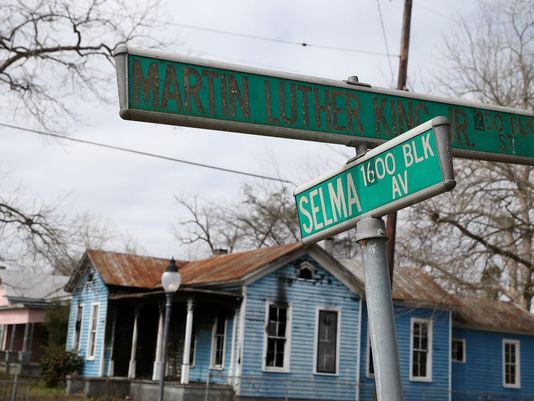Stuff Black People Don’t Like
December 26, 2015
Fifty years is a blink of an eye.
For one American city, it represents an eternity.
Fifty years ago, Selma was booming.

Today, it’s an 80 percent black city representing nothing less than a reminder those white cops on Edmund Pettus Bridge were the true heroes.
The only movie theater in town is operated by a non-profit organization (the aptly named All Things Are Possible), while the city regresses to the black mean.
It’s a city where every stereotype of blackness came true.
And yet, even though the city of Selma owns and operates the historic St. James Hotel, only one weekend out of year do people even dare venture into the 80 percent black nightmare that is Selma: to celebrate the entire fictional ‘liberation’ of the city some 50 years ago when black people and their white enablers marched across a bridge. [Lingering woes at historic Selma hotel, Montgomery Advertiser, December 13, 2015]:
Dec. 12, 1997, was a cold, wet, dreary night, but nobody seemed to mind because they were being treated to a Hollywood-type re-grand opening of a hotel with positive credentials dating back to the first half of the 19th century.
Smiles abounded as local residents and invited guests from around Alabama walked slowly over a red carpet, shaking hands with Selma officials and basking in a special glow on a winter night they weren’t likely to forget.
One of the officials greeting the big crowd that night was Selma City Councilman Cecil Williamson, a minister and future lawyer who was floored by the opulence inside the St. James Hotel.
Built in 1837, it was one of the first major hotels in Alabama, a relatively new state admitted to the Union just 18 years before.
The St. James weathered the Civil War storm when Yankees galloped into town and burned most of it to the ground, but saved the hotel so that it could be used as a headquarters for occupation troops.
Decades later, the hotel fell into disrepair and was turned into a tire recapping business on Water Avenue, one of the oldest riverfront business districts in Alabama.To the rescue came a group of local leaders including millionaire industrialist Larry Striplin, a local boy who made good, Elizabeth Driggers, director of Selma’s community development department and U.S. Sen. Richard Shelby who used his political clout to gain funding to help the hotel.
It all led to that glittering grand re-opening as 1997 drew to a close. Hopes for the future had never seemed brighter and that’s just what happened, for a few years.
Alas, such was not to be for an extended period. The St. James doesn’t look all that bad from the outside, but the interior tells another story and that’s where our sad story sits today.
“It’s a white elephant that needs to be closed,” Williamson said a few days ago. “It hasn’t broken even since it opened. No one will put $20,000 a month into a failing business. This is financial insanity.”
That pretty much sums up the situation today. The City of Selma doesn’t need to be in the hotel business, but it has owned the facility for much of its existence.
Detractors recite a litany of reasons for the sorry situation—ranging from poor management to lagging occupancy in a hotel with only 40 rooms. Many ideas have been proposed to turn things around but nothing seems to work.
The only sure thing is super support every March when America celebrates the annual Bridge Crossing Jubilee, an event that commemorates “Bloody Sunday” and the subsequent historic march from Selma to Montgomery in 1965.
Rooms at the St. James are reserved a year in advance. Larger Selma motels with many more rooms are also filled.
Managers come and go as expenses continue to obliterate the bottom line. According to a report at a recent meeting of the Selma City Council, the city has spent $187,000 more on the hotel than it’s received in revenue during past months.
During interviews, Williamson comes prepared with plenty of financial reports and statistical information to substantiate his belief the St. James appears to be operating on borrowed time.
Management resuscitators seem to come out of the woodwork with plans to save the St. James, but they’ve all fizzled. One guy sauntered into a council meeting a decade ago with a proposal to turn the hotel into a “Global Peace Center,” a place to mediate “global conflict.”
What a doozy that was! Selma doesn’t seem able to resolve local problems, let alone concern over the price of tea in China or actually finding honest officials directing the Olympics.
The latest idea to save the hotel comes from a Selma Ivy Leaguer who has a plan to buy the St. James for $1 in exchange for an investment of $1 million and possibly more over the next three years. It would be part of a more extensive plan he has put together.
The low point confronting the beleaguered facility occurred two years ago when Nancy Smith and Patty Sexton became unpaid volunteers in an effort to help cut costs and keep their hometown hotel open.
So, there they were, scrubbing toilets, making the beds and washing the sheets in a two-month example of what community volunteerism is all about.“I’m glad Elizabeth doesn’t have to see what’s happened to the hotel,” said Williamson, referring to the late community development director. “She’d have a hard time looking at its deplorable condition.”
Stay tuned for the next development in the lingering disaster known as the St. James Hotel. At the moment, it looks more like an illustration for the St. James Infirmary and that’s certainly nothing to toot a horn over.
Every March, the eyes of the nation turn to Selma, Alabama and the usually empty St. James Hotel is full, because there still exists mileage out of the white guilt trip the Edmund Pettus Bridge represents.
But for 51 other weeks, the city of Selma – that 80 percent black nightmare in Alabama – represents exactly why white people once dared stand in the way of what white liberals always claim is “progress.”
The “deplorable condition” of the St. James Hotel is a reminder of what happens to the civilization white people built when a proliferation of black people happens all around it.
80 percent black Selma represents the ultimate white liberal yearly pilgrimage, where those pulling the levers of Black-Run America (BRA) can still trot out a few Civil Rights-era blacks and say, “thank god these people walked across the bridge to usher in a equality.”
Funny though: all I see in 2015 Selma, an 80 percent black nightmare, is the exact manifestation of why white people dared stand in the way of what white liberals deem is progress, for it represented the complete regression of the civilization white individuals collectively built.
There’s nothing in Selma to celebrate. All that is left of the civilization white people built long ago in Selma is worth lamenting, a poignant reminder of the failure of forced integration.
 Daily Stormer The Most Censored Publication in History
Daily Stormer The Most Censored Publication in History


